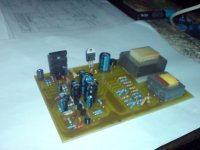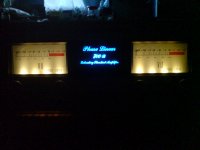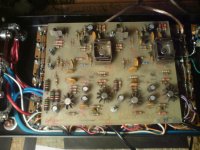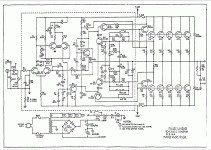I've measured a 1 MHz oscillation that is about 85 mV peak to peak at the speaker terminal of the phase linear 400.
Same oscillation is present on all signal grounds *throughout* the system.
Is this what folks consider oscillation? It seems quite benign....
FYI: The line level gear is powered with a balanced power supply. The power supply is a DIY, a corcom multiprocessor controlled relay is used in the soft start circuit.... it ramps up the voltage over 1 second until it switches a solid state relay.
This relay is controlled by a 12 volt SMPS.
Could this be puking this oscillation into the system? or perhaps the Rotel RCD-855 CP player I am using as a transport? Or perhaps the benchmark USB DAC? The benchmark is not on balanced power, nor is the amp....
Any help here as to the cause of this oscillation would be very appreciated.
BTW: The phase linear grounding circuit is changed. The shield grounds have been moved from the speaker negative directly to the PS common.
Should I be concerned?
Thanks!
Same oscillation is present on all signal grounds *throughout* the system.
Is this what folks consider oscillation? It seems quite benign....
FYI: The line level gear is powered with a balanced power supply. The power supply is a DIY, a corcom multiprocessor controlled relay is used in the soft start circuit.... it ramps up the voltage over 1 second until it switches a solid state relay.
This relay is controlled by a 12 volt SMPS.
Could this be puking this oscillation into the system? or perhaps the Rotel RCD-855 CP player I am using as a transport? Or perhaps the benchmark USB DAC? The benchmark is not on balanced power, nor is the amp....
Any help here as to the cause of this oscillation would be very appreciated.
BTW: The phase linear grounding circuit is changed. The shield grounds have been moved from the speaker negative directly to the PS common.
Should I be concerned?
Thanks!
The frequency of the signal is a clue as to where it is coming from. Examine all the stages (the signal, not the ground) and any ancillaries such as the PSU to see where it is arising.
It's odd that you say it's on the signal ground. Does it disappear when you short the scope probe?
w
It's odd that you say it's on the signal ground. Does it disappear when you short the scope probe?
w
Which series is this amp. Original or 2 with an opamp at the input.....analogue or led VU meters? I have 700b amp. This oscillation is maybe not oscillation but local SW AM station. They transmit somewhere around 1 MHz. If that is radio than is possible to observe some difference in amplitude of this oscillation. In rhythm of speech or batter named modulation......
It's been years since I've worked on a PL amp. But I do remember they were subject to oscillations. The first thing I'd look at is the RC network located at the speaker terminals.
This RC network is critical to the PL and if it's speaker terminals have been altered I'd expect oscillation to be the first symptom.
I'd not run this amp until it's been serviced!
This RC network is critical to the PL and if it's speaker terminals have been altered I'd expect oscillation to be the first symptom.
I'd not run this amp until it's been serviced!
If it is on the ground , are you referencing to a technical ground or another "unused ground" in the house wiring. All the dang CFL lighting , PC 700w PS's , and all that other switching stuff dump tons of 100k-1mhz "garbage" on that mains circuit ground as well as line.
I have a separate mains for my PC - lighting - audio (heavy 20A - direct to earth rod) I saw the pc's effect on a common ground (PC/audio combined). If you do this with a sound card-PC / amp, it would be advisable to use isolation or a DAC as there would be a long ground loop created. Just a thought...
OS
I have a separate mains for my PC - lighting - audio (heavy 20A - direct to earth rod) I saw the pc's effect on a common ground (PC/audio combined). If you do this with a sound card-PC / amp, it would be advisable to use isolation or a DAC as there would be a long ground loop created. Just a thought...
OS
ostripper,
The system is plugged into a dedicated line. There are two duplex receptacles on the line. One has the DIY Balanced Power, and the amp. The other has the DAC and a spare power bar -- the scope gets plugged into that power bar.
When I turn the amp off, the oscillation is still present on the signal grounds elsewhere, but not as strong.
The system is wired with Neotech Microphone cable, one conductor for signal, the other for return. The shield is connected at the target end only.
The amp is the PL14 board, with 39K input impedance -- the latest version according to the service manuals.
I think there may be multiple sources -- the CD player and SMPS on the balance power supply look like good candidates.
However, this oscillation was still there when the phase was run without input or output connected on a different circuit. That does not mean the power is clean on either circuit.
Changes:
1) All the ceramic capacitors on the PCB. Some where 0.05 uf at 35%. These were all changed to 0.047 uf at 1% (Vishay/Roederstein MKP1837, at $1 each).
2) the grounding, as suggested elsewhere... the RCA shield was disconnected from the speaker negative and a separate line was run to power common from the RCA shield.
3) the wiring harness -- 18 guage replaced the existing wiring. The PCB was drilled to accomodate.
4) all the electrolytics (Elna Silmic II) on the PCB and the power supply (2 x Jensen 4-pole at 10,000 uF each).
5) both RCA jacks.
6) Output cap on the Zobel.
7) Q1/Q2 swapped for MPSA06, hfe matched at 250.
8) Q3/Q4 swapped for MPSA93 as per schematic.
9) Q5 (left channel only) replaced with same part as in right channel.
10) numerous diodes
11) PS supply Bridge replaced with IXYS 32A Hexfred.
12) Signal path resistors and feedback resistors replaced with Caddock MKP132 equivalent.
13) New power cord with earth screwed to chassis, marinco plug. (12 gauge conductors)
DC offsets measure at -3.4 mv LC and 7.2 mv RC. Bias is set to .425 Volts each side. It is stone cold even when left on overnight.
Since I just got the scope, I can't tell you if the oscillation was there before or not.
This amp barely sounds like a phase linear anymore -- though it is still a touch bright.
Planned changes:
1) Add 0.003 uF 2% to the caps in the protection circuit to bring the total to 0.05 uF. (This location is very sensitive to the quality and value of the cap used -- tonal balance changes with the size in uF, quality changes with the type of cap.)
2) Emitter resistors on the outputs and drivers to 5W "non-inductive" wirewound (Mills).
3) Zobel resistors also to the 5W Mills resistors.
4) Speaker binding posts.
5) possibly add CCS to Q1/Q2.
I always thought that the oscillation mentioned was destructive, and at a higher voltage level than 85 mv. This is almost an acceptable DC offset!
I also thought that the main cause for these amps to oscillate was incorrect/poor output transistors. I will check to see what these are before proceeding. They were changed by a previous owner.
I suppose this could actually be the main problem.
The system is plugged into a dedicated line. There are two duplex receptacles on the line. One has the DIY Balanced Power, and the amp. The other has the DAC and a spare power bar -- the scope gets plugged into that power bar.
When I turn the amp off, the oscillation is still present on the signal grounds elsewhere, but not as strong.
The system is wired with Neotech Microphone cable, one conductor for signal, the other for return. The shield is connected at the target end only.
The amp is the PL14 board, with 39K input impedance -- the latest version according to the service manuals.
I think there may be multiple sources -- the CD player and SMPS on the balance power supply look like good candidates.
However, this oscillation was still there when the phase was run without input or output connected on a different circuit. That does not mean the power is clean on either circuit.
Changes:
1) All the ceramic capacitors on the PCB. Some where 0.05 uf at 35%. These were all changed to 0.047 uf at 1% (Vishay/Roederstein MKP1837, at $1 each).
2) the grounding, as suggested elsewhere... the RCA shield was disconnected from the speaker negative and a separate line was run to power common from the RCA shield.
3) the wiring harness -- 18 guage replaced the existing wiring. The PCB was drilled to accomodate.
4) all the electrolytics (Elna Silmic II) on the PCB and the power supply (2 x Jensen 4-pole at 10,000 uF each).
5) both RCA jacks.
6) Output cap on the Zobel.
7) Q1/Q2 swapped for MPSA06, hfe matched at 250.
8) Q3/Q4 swapped for MPSA93 as per schematic.
9) Q5 (left channel only) replaced with same part as in right channel.
10) numerous diodes
11) PS supply Bridge replaced with IXYS 32A Hexfred.
12) Signal path resistors and feedback resistors replaced with Caddock MKP132 equivalent.
13) New power cord with earth screwed to chassis, marinco plug. (12 gauge conductors)
DC offsets measure at -3.4 mv LC and 7.2 mv RC. Bias is set to .425 Volts each side. It is stone cold even when left on overnight.
Since I just got the scope, I can't tell you if the oscillation was there before or not.
This amp barely sounds like a phase linear anymore -- though it is still a touch bright.
Planned changes:
1) Add 0.003 uF 2% to the caps in the protection circuit to bring the total to 0.05 uF. (This location is very sensitive to the quality and value of the cap used -- tonal balance changes with the size in uF, quality changes with the type of cap.)
2) Emitter resistors on the outputs and drivers to 5W "non-inductive" wirewound (Mills).
3) Zobel resistors also to the 5W Mills resistors.
4) Speaker binding posts.
5) possibly add CCS to Q1/Q2.
I always thought that the oscillation mentioned was destructive, and at a higher voltage level than 85 mv. This is almost an acceptable DC offset!
I also thought that the main cause for these amps to oscillate was incorrect/poor output transistors. I will check to see what these are before proceeding. They were changed by a previous owner.
I suppose this could actually be the main problem.
uuuups first one is wrong. Sorry.
Wow ! look at the ferrite beads on the rails. 😱 This might be a amp on the "edge" (like the goldmund). Is it MOSFET OPS ?
PS - found schema , looks like a dual differential input stage driving a bootstrapped VAS followed by a triple OPS. strange indeed...
OS
Attachments
Last edited:
That is a similar amp, but it seems there is slightly more to it than mine... including stuff in the protection circuit....
Mine is at www.hifiengine.com, in the service manual. Is it possible to post a pdf here? I don't know how else to get it out....
Mine is at www.hifiengine.com, in the service manual. Is it possible to post a pdf here? I don't know how else to get it out....
Last edited:
A number of your changes could cause RF oscillation in an already marginal circuit. You may need to start reversing them and see what kills the oscillation. You can't just change components and grounding willy-nilly and expect everything to work OK. In particular, if a capacitor is there for RF decoupling then changing it to a 'better' component could make things worse!
The 1 MHz noise was present on all signal grounds even when the amp is off, although there was less of it. Turning the amp on, reinforces the noise, but it is not the generator.
The change to the grounding scheme ( remove the RCA shield from the speaker negative, and provide connection from RCA direct to power common) is common. This change has been supported here and by others on other forums.
Turning off the CD player also reduces it somewhat. I will change the SMPS on the balanced power today to a linear and see any effect.
Also, I will try grounding the probe -- although the ground strap on the probe is broken --will alligator clips do the trick?
If I hold the probe a certain way, I think I "ground" it, and the "oscillation" vanishes -- it drops to about 2 mv pk to pk. I'm now suspecting the measurement technique.
The change to the grounding scheme ( remove the RCA shield from the speaker negative, and provide connection from RCA direct to power common) is common. This change has been supported here and by others on other forums.
Turning off the CD player also reduces it somewhat. I will change the SMPS on the balanced power today to a linear and see any effect.
Also, I will try grounding the probe -- although the ground strap on the probe is broken --will alligator clips do the trick?
If I hold the probe a certain way, I think I "ground" it, and the "oscillation" vanishes -- it drops to about 2 mv pk to pk. I'm now suspecting the measurement technique.
Yes - use some kind of ground, a clip will do. I suspect that you really dont have a problem, but the lack of ground is allowing the scope to pick radio frequency interfearance. Good Luck.
Sorry, didn't notice that. Your long list of mods threw me off the scent!BigE said:When I turn the amp off, the oscillation is still present
Also, I will try grounding the probe --
Your measuring without a probe ground? That may be the entire problem. The scope is referencing its mesurements to the scope case and the unattached ground wire in the probe is an antennae.
Last edited:
If you have 2 probes you can also use one on the ground and set the scope to A-B the 2 probes, taking the scope ground out of the measurement. (convert it to a balanced input)
Last edited:
Well, I tried an alligator clip to a piece of wire stuck into the third prong of a power bar and the other end to the broken probe ground, but it still showed oscillation.
If I stick my finger on it, it shows *way* more noise. I don't think there is a problem here.
If I stick my finger on it, it shows *way* more noise. I don't think there is a problem here.
Hi to all.
Just something more. My experience with PL amps......At my 700b i noticed some instability. I also work on 700 series2 clone. It oscillate like hell. But once again. I have SW broadcast station some 20 Km away and i can observe its signal on scope on several devices. Diy or factory. Those transmitters work with very high output powers and are AM modulated to make things even worse.......
Hey Ostripper. Mmmmmm......ferrite beads.....I like them....he he he...This amp rocks. Almost endless power at +-100V. And i remove protection circuit..well at least those ugly germanium transistors which cause a lot of these amps to fail....and mow much power now deliver this peace of heavy metal? I don't know but when mains fall down to 200VAC i stopped before destroy something. And dummy load was smokey hot....Anyhow. This amp is nice sounding. Somehow warm but not without presence.....bla bla..It's good amp for its age.
Bee good
Just something more. My experience with PL amps......At my 700b i noticed some instability. I also work on 700 series2 clone. It oscillate like hell. But once again. I have SW broadcast station some 20 Km away and i can observe its signal on scope on several devices. Diy or factory. Those transmitters work with very high output powers and are AM modulated to make things even worse.......
Hey Ostripper. Mmmmmm......ferrite beads.....I like them....he he he...This amp rocks. Almost endless power at +-100V. And i remove protection circuit..well at least those ugly germanium transistors which cause a lot of these amps to fail....and mow much power now deliver this peace of heavy metal? I don't know but when mains fall down to 200VAC i stopped before destroy something. And dummy load was smokey hot....Anyhow. This amp is nice sounding. Somehow warm but not without presence.....bla bla..It's good amp for its age.
Bee good
Surely your scope probe should be grounded at 0V - the ground point where the power supply capacitors connect would be the best place. Grounding the probe to mains earth is just going to create a huge ground loop.
- Status
- Not open for further replies.
- Home
- Amplifiers
- Solid State
- phase linear "oscillation"



